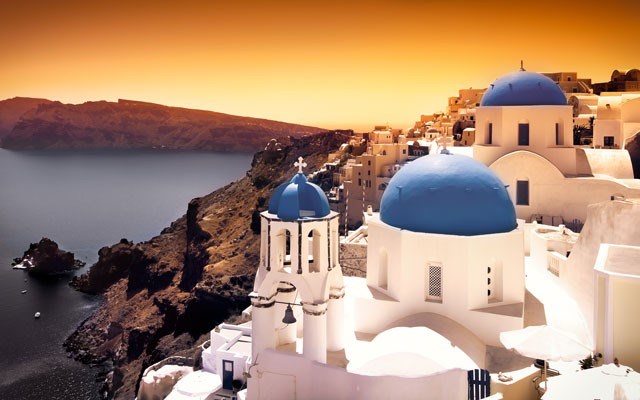The Cyclades island group in Greece – pronounced Kick-la-des – is a sun-drenched arc-shaped archipelago scattered like white pebbles around the crystal-clear Aegean Sea.
I was a few days into a 10-day long Greek island hopping adventure when we found ourselves following the road along Milos's dramatic northern coastline. The route carries on west along the coast to the coves of Papafragos and Kapros — quiet, secluded spots for a swim in the crystal-clear waters, before reaching St. Constantine where you'll find traditional "syrmata," or fisherman's huts, cut into the rocks of the beachfront.
Although now holiday homes, they're still one of the most distinguishing features of the Milos coastline. Slightly further along the coast, we arrived with an appetite to the wonderful Medusa restaurant, a hidden gem and perfect lunch spot overlooking the ocean, serving up huge portions of fresh fried fish and Greek salad, among other tasty local dishes.
The typical Cycladic hilltop town of Plaka on the west side of Milos isn't far from Mandrakia. Here, its maze of delightful cobbled streets filled with pretty white houses with archetypal blue-painted front doors, and shops selling arts and crafts, link to those of the nearby town of Tripiti, offering plenty of opportunity for meandering, as well as learning more about the island's ancient history at the appointment-only archaeological museum.
There are lots of places to eat and drink in both of these towns, too, but if you're strapped for time, make sure you're in Plaka for a cocktail in time to watch the sun set over the sea at the stylish Utopia Café on the city's western edge; before a tasty homemade dinner at the extremely popular family-run Argondoula restaurant just round the corner, with tables that spill out onto the streets.
Pretty and vibrant Milos really made the perfect Greek island holiday destination, but all too soon it was time to leave.
I was, however, excited for my next ferry trip to the tiny three-kilometre island of Folegandros, just an hour away, and made up of three small villages with a population of around 770 (Milos has a population of about 5,000).
Even more remote and rocky than Milos, despite its unrivalled scenery and beautifully unspoiled beaches — arguably some of the best in the Cyclades — it remains a perfect Greek hideaway, firmly off the package-tour radar. If you can peel yourself away from one of its many unspoilt beaches, the island is easily explored in a day.
We took our time, driving through its centre on the only main road, taking in the spectacular views out to sea on both sides and stopping at a highly recommended bakery for a taste of the island's famous kalassouna, Greek cheese pie — indulgent layers of filo pastry stuffed with melted souroto, a delicious local white cheese. We made our way to Angali beach, where we spent most of our time snorkelling and sea kayaking; making sure to take regular breaks at one of the beachside tavernas to cool down.
Away from the beach, Chora, the island's main town, with its central square in the middle of the kastro, is a nice place to wander through, and is packed with cafés and tavernas, which come alive at night.
Pounta taverna at the Chora entrance is a good choice, serving particularly delicious moussaka and rabbit stew in a pretty courtyard on pottery made by the café's Danish owner.
For a special breakfast with a view, head to the enviably located Anemomilos Apartments opposite Pounta. With magnificent views out to the Aegean, you'll be hardpressed to tear yourself away, unless of course you're lucky enough to have a room here.
From here, we took the short walk up the steps to the picture-perfect Panagia Church for spectacular views across the whole of the island.
Suitably relaxed after three days on Folegandros, I'd really learned to slow down, and was extremely reluctant to leave. I'd felt more relaxed than I had in ages, and although I would deeply miss this island haven, I was nevertheless curious to discover why people flocked in droves to Santorini. Surely I must be missing something?
As an alternative to central Fira on Santorini, we stayed in Imerovigli, an attractive town on the caldera — the flooded crater created by a volcanic eruption 3,500 years ago. It wasn't until I caught a glimpse of the caldera at sunset that I began to warm to this over-subscribed Greek island and appreciate why it is one of the world's top honeymoon destinations.
Come dusk, savouring the sunset from our balcony with a cool glass of Assyrtiko from the local award-winning Sigalas winery, looking down on the giant cruise boats trickling in and out of the port, the beach became drenched in bright orange sunlight and the sky turned purple.
For miles around, we watched as the colours increased in intensity as the sun sank deeper down in the sky, finally hitting the sea, the lights from the apartments lining the caldera starting to twinkle.
This is what all the fuss was all about.
This is what I had missed.
This is the second of two parts on travelling the Greek isles by Ellie. For part one go to www.piquenewsmagazine.com.




